 |
||||
|
|
||||
 Greensboro was once described as a "chosen center," placed purposefully in the middle of Guilford County in 1808 for political reasons, but the Quaker founders of Jamestown established their community for economic reasons. They wanted to harness the waters of the Deep River to saw wood, grind grain, and turn lathes as they created the nation's first manufacturing capabilities, small as they started off. First settled around 1752, by the late 1700s, several brick buildings faced the federal road that ran through Jamestown, making it the first place in Guilford County, North Carolina to actually look like a town. Jamestown was a designated polling place in the late 1790s and granted a state charter in 1812. The town's namesake is James Mendenhall, who built Mendenhall Plantation around 1800 - still standing today. This early 19th-century Quaker plantation includes many unique outbuildings, a museum, and one of two existing false-bottom wagons used to transport runaway slaves during the time of the Underground Railroad. During the 1800s, the Mendenhalls established a school in the town. Eventually other schools were also established in the early days such as Jamestown Female College, a Law School, Coffin Medical School, Fling Hill School, Oakdale School, and Jamestown Elementary School. During the 1800s, textiles and other industries thrived in the area thanks to Jamestown's location and resources. The Oakdale Cotton Mills company was one of the area's earliest industrial enterprises. During the American Civil War, the factory was converted to produce guns for the Confederacy. In 1832, Cornish engineer Charles T. McCulloch and Elizer Kersey built the "McCulloch Gold Mill," which is on the National Register of Historic Places. Many people call it Castle McCullough because it looks like an Old World castle with its drawbridge, stone construction, and huge rooms with tall ceilings. Jamestown was granted a US Post Office on February 21, 1811, and its first Postmaster was Mr. John Charles. It has been in continuous operation ever since. |
 |
 |
© 2007 - J.D. Lewis - PO Box 1188 - Little River, SC 29566 - All Rights Reserved